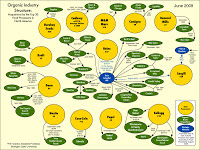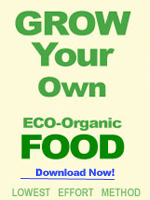 |
| Organic Industry Structure Click Image to Enlarge |
Catherine J. Frompovich
Activist Post
Do you ever consider why the public responds to situations as it does; likes certain products; or even to what people think or believe to be fact or truth? Probably, very few individuals consider much of what they hear in news broadcasts, read in newspapers and magazines, or see on television to be false, fabricated, or fashioned to control the masses. Isn’t that considered conspiracy theories? However, nothing is further from reality when it comes to policy-making in the United States.
Every corporate entity—and even government agencies—“worth its salt” finances lobbyists, front groups, or special operations to make unsuspecting citizens and consumers—no matter what the commodity or cause is—believe its version of “right being wrong,” “bad is good,” and, if they could, convince you that black is white. The method is called public relations campaigns.
Nothing exemplifies those tactics more than what’s going on currently on every front in commerce, industry, health, and politics. Probably the industries most ‘tarnished’ for promoting and protecting their vested interests are Big Pharma, Big Ag, and Big Food. All three maintain huge lobbying presences on Capitol Hill in Washington, DC, and in the media through colossal advertising that directly influences consumers’ buying habits. Just how seriously skewed such campaigns are—especially those by Big Ag and Big Food—was brought to light recently by the Center for Food Safety’s report “Best Public Relations That Money Can Buy: A Guide To Food Industry Front Groups.”[1]
As that report states, “It is critical to understand who these groups are and how they operate.” Some are legitimate trade groups while others are front groups, which often disappear after a PR campaign is launched successfully and won, as happened in November 2012 in California with the defeat of Proposition 37 regarding the labeling of genetically modified food. The group was organized to defeat Prop 37 and financed by none other than Monsanto—premiere GMO developer—and PepsiCo., not a “coalition of family farmers, grocers, food companies, small businesses and others.”[2] The PR campaign used scaremongering techniques to get voters to believe that passing Prop 37 would raise the cost of food by hundreds of dollars per year.
Megabucks advertising campaigns won the day for GMOs not having to be labeled in California, and for which consumers ultimately may have to pay with compromised health, since no long-range studies have been done on the effects of GMOs in humans. Doctor Len Saputo in the San Francisco Bay area says, “The European Food Safety Authority (EFSA) belatedly discovered that of the 86 GMO foods developed, 54 contain a virus called Gene 6 that has not been cleared for safety! Gene 6 may also disturb the normal health of crops, including their natural pest resistance as well as human health.” [CJF emphasis added] Wasn’t that money well spent by Monsanto and PepsiCo. in order to protect vested interests but, undoubtedly, not factual?
That type of influence works at government agency levels most efficiently, as corporations supply the feds with information they want the feds to review to approve products, especially Big Pharma. What a scheme!
 So, who are some of these food industry groups? Each animal food group has its own food industry trade group such as the National Cattleman’s Beef Association, National Pork Producers Council, The National Chicken Council, U.S. Poultry & Egg Association, and at least ten dairy associations. Other groups include the American Beverage Association, which represents the soft drink industry, and the Grocery Manufacturers Association, representing food and beverage makers. These are trade groups or associations that function differently from front groups, who often have deceptive sounding names in order to sway public opinion in their favor.
So, who are some of these food industry groups? Each animal food group has its own food industry trade group such as the National Cattleman’s Beef Association, National Pork Producers Council, The National Chicken Council, U.S. Poultry & Egg Association, and at least ten dairy associations. Other groups include the American Beverage Association, which represents the soft drink industry, and the Grocery Manufacturers Association, representing food and beverage makers. These are trade groups or associations that function differently from front groups, who often have deceptive sounding names in order to sway public opinion in their favor.
According to the Center’s report, one of the powerful front groups attempting to control public dialogue on agriculture is the U.S. Farmers and Ranchers Alliance.[3] Their main agenda is to knock and criticize those consumers who question the overuse of antibiotics, GMO crops, and the confining or abusive treatment of farm animals, as ignorant city dwellers who really don’t know anything about farming. Better to get those ‘facts’ from the Alliance.
The report lists as examples of front groups: Sensible Food Policy Coalition whose marketing focuses on children; New Yorkers for Beverage Choices, which opposed Mayor Bloomberg’s sugary beverage cup size proposal in New York City; and the Community Coalition Against Beverage Taxes, which successfully fought the 2012 Richmond, California, soda tax ballot measure.[4]
Longer-standing front groups include: Alliance for Food and Farming, Animal Agriculture Alliance, Center for Consumer Freedom, International Food Information Council Foundation, and the American Council on Science and Health.
Other recently-formed front groups are: Alliance to Feed the Future, America’s Farmers, Center for Food Integrity, Global Harvest, Protect the Harvest, U.S. Alliance for Farmers and Ranchers.
Then there are scientific “institutes” of food manufacturers who, according to the report, include: Bell Institute of Health and Nutrition (General Mills), Beverage Institute for Health and Wellness (Coca-Cola), Conagra Foods Science Institute, Gatorade Sports Science Institute, and the Nestlé Nutrition Institute. To understand more about these groups, please visit the Center for Food Safety’s report where you can read each group’s mission, who funds it, and how it operates.
 What’s not found in the report are actual citizen-based associations who put out information the food industry apparently wants suppressed about GMOs, animal husbandry, organic farming, etc. These include the Organic Consumers Association, The Institute for Responsible Technology, and The Weston A. Price Foundation. Another organization that works in the public health interest is Center for Science in the Public Interest.
What’s not found in the report are actual citizen-based associations who put out information the food industry apparently wants suppressed about GMOs, animal husbandry, organic farming, etc. These include the Organic Consumers Association, The Institute for Responsible Technology, and The Weston A. Price Foundation. Another organization that works in the public health interest is Center for Science in the Public Interest.
As an aside, readers may want to know how the Organic Food Industry is structured, e.g., who owns whom. It may not be what consumers think. Some of the largest food ags own organic brands. Check it out here, or click the image above.
However, nothing can compare with food industry groups PR efforts like Big Pharma’s advertising when launching new products. The big difference between food and medical groups, in this writer’s opinion, is the strong arm of the U.S. CDC/FDA, which embraces rhetoric that often is nothing short of scientific spin, especially when it comes to vaccine issues, and frequently tragic unreliable research upon which drug approvals are made. Nothing proves that statement more than the following interesting websites:
- FDA Let Drugs Approved on Fraudulent Research Stay on Market http://www.propublica.org/article/fda-let-drugs-approved-on-fraudulent-research-stay-on-the-market
- Study: Scientific research fraud on the rise (CBS News) http://www.cbsnews.com/8301-204_162-57523932/study-scientific-research-fraud-on-the-rise/
- Misconduct Widespread in Retracted Science Papers, Study Finds (The New York Times) www.study-finds-fraud-is-widespread-in-retracted-scientific-papers.html
- False positives: fraud and misconduct are threatening scientific research (The Guardian, UK) http://www.guardian.co.uk/science/2012/sep/13/scientific-research-fraud-bad-practice
Two questions this writer invites readers to consider: Why does the public believe slick advertising campaign agendas that apparently don’t have consumers’ best interests at heart? What do you think the main agenda is: control or greed? Or, is it both?
Notes:
[1] http://www.centerforfoodsafety.org/files/front_groups_final_84531.pdf
[2] Ibid. p.8
[3] Ibid. p.6
[4] Ibid. p.9
Catherine J Frompovich (website) is a retired natural nutritionist who earned advanced degrees in Nutrition and Holistic Health Sciences, Certification in Orthomolecular Theory and Practice plus Paralegal Studies. Her work has been published in national and airline magazines since the early 1980s. Catherine authored numerous books on health issues along with co-authoring papers and monographs with physicians, nurses, and holistic healthcare professionals. She has been a consumer healthcare researcher 35 years and counting. Catherine’s latest book, A Cancer Answer, Holistic BREAST Cancer Management, A Guide to Effective & Non-Toxic Treatments, is available on Amazon.com and as a Kindle eBook. Two of Catherine’s more recent books on Amazon.com are Our Chemical Lives And The Hijacking Of Our DNA, A Probe Into What’s Probably Making Us Sick (2009) and Lord, How Can I Make It Through Grieving My Loss, An Inspirational Guide Through the Grieving Process (2008).
linkwithin_text=’Related Articles:’


Be the first to comment on "Corporate Control Mechanisms Inside The Organic Food Industry"